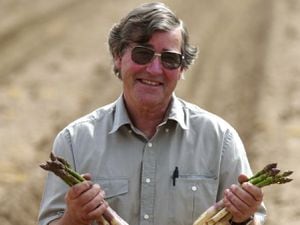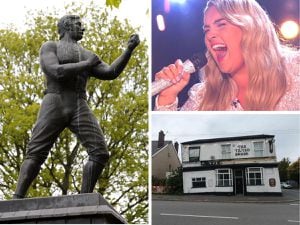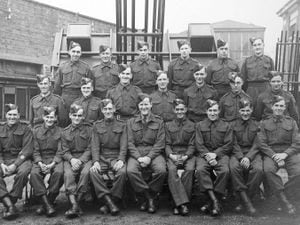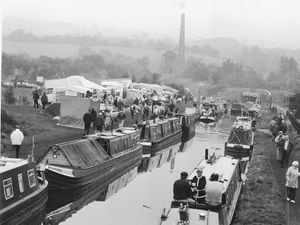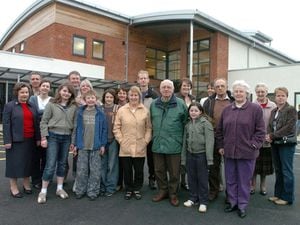How the West Midlands reached for the skies with Spitfire funds
During the Second World War, the RAF couldn't get enough of the Supermarine Spitfire. Literally.
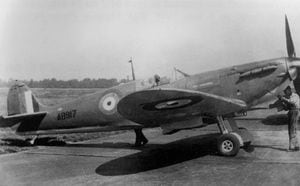
Along with the Hawker Hurricane, the Spitfire was crucial to defeating the Luftwaffe in the Battle of Britain, forcing Hitler to abandon his plans to invade Great Britain. And in the early stages of the Second World War, the RAF was desperate for as many as it could get.
And the people of the West Midlands rode to the rescue. The Express & Star led a fundraising campaign in Wolverhampton, which paid for two Spitfires, which were named The Inspirer and Wulfrun. Neighbouring Walsall also managed a pair, although they were less imaginatively titled Walsall I and Walsall II. Dudley donated The Dauntless, and Stafford the Staffordian.
There were also planes named after Halesowen, Smethwick, Lichfield, Willenhall, Brierley Hill, West Bromwich and Rowley Regis, not to mention one bearing the snappily moniker of Kidderminster, Bewdley and Stourport.
The idea of community fundraising initiatives to pay for planes was first tried in the UK during the First World War.
Clare Carr, assistant curator at the RAF Museum at Cosford, says donations were not raised for specific aircraft, but a scale was produced to indicate to the public what their money could buy.
"£1,500 would buy a BE2c, £2,250 a Vickers Gunbus and £3,500 a Short floatplane," she says.
It was during the Second World War that the idea truly gained momentum, under the dynamic leadership of media baron Lord Beaverbrook, who Churchill appointed Minister of Aircraft Production. While the real cost of building a Spitfire actually cost more than £8,000, Beaverbrook set a nominal price of £5,000 and challenged companies, organisations and communities to sponsor their own planes.
"The Spitfire captured the public imagination like no other aircraft," says Clare. "Communities and individuals around the world responded to raise funds for ‘their’ Spitfire."
One of the first Spitfire funds was set up by the Wolverhampton Express and Star newspaper, which had raised £1,250 by June 18, 1940, just a few days after the fund was launched. A total of £6,746 was raised and Spitfire Mk. Vb AB917 was subsequently allocated and named ‘The Inspirer’, for being one of the first funded aircraft. A Ministry of Aircraft Production plaque was presented to the newspaper in honour of the fund, which is now on display at the Cosford museum.
Although purchased in 1940, ‘The Inspirer’ did not begin its operational service until January 1942 when it was assigned to No. 401 (Royal Canadian Air Force (RCAF)) Squadron at RAF Gravesend in Kent. As part of the Biggin Hill Wing alongside Nos. 72 and 124 Squadrons, No. 401 Squadron carried out fighter sweep operations over France, providing fighter cover to medium bomber squadrons attacking targets such as railways, factories and military sites.
With No. 401 Squadron at this time was Pilot Officer Donald Blakeslee, an American who by the end of the Second World War had flown more combat missions than any other American fighter pilot. Blakeslee flew AB917 on 4 April 1942 as part of a Wing Sweep escorting Boston medium bombers targeting St. Omer railway station.
Pictured on the wing of ‘The Inspirer’ is 21-year-old Sergeant Alexander Douglas Blakey, also of No. 401 (RCAF) Squadron, who was killed a few days after the picture was taken while flying another Spitfire, which broke up during an air test.
Clare says AB917 was principally flown by Pilot Officer Gerald Bickle Whitney, a 21-year-old Canadian born in Ontario but resident the USA.
"Whitney took AB917 on fighter sweeps to Dunkirk, convoy protection patrols over the English Channel, offensive air patrols seeking out Luftwaffe opposition, and air-sea rescue support sorties," she says.
On April 28, 1942, the squadron was providing top cover in a wing sweep for a formation of Boston medium bombers targeting St Omer in France.
"They ran into formations of German Me 109s and FW 190s and Blakeslee and Whitney in AB917 dived to intercept but were themselves attacked," says Clare.
Blakeslee made two successful attacks on the FW 190s, but The Inspirer was damaged by enemy fire. Whitney managed to get the aircraft back across the Channel, but crashed in the village of Whitfield near Dover. He is buried in Brookwood Military Cemetery, Woking.
Following the success of the first fundraising effort, a second Wolverhampton fighter fund began, this time championed by the Mayor of Wolverhampton. It raised £5,076 and the second aircraft Spitfire MkVb P8715 was named ‘Wulfrun’ after Lady Wulfruna, the Anglo-Saxon noble who founded Wolverhampton.
First delivered in 1941 to No. 19 Squadron, by April 1943 ‘Wulfrun’ was with another Royal Canadian Air Force squadron, No. 411 stationed at RAF Kenley in Surrey. It became the regular aircraft of Flight Lieutenant William Thomas Johnstone, a 25-year-old native of Calgary. Johnstone joined the Royal Canadian Air Force in 1940 and had served in Canadian squadrons in the UK since 1941.
With Wulfrun, Johnstone participated in fighter sweeps, patrols and bomber escort operations. On March 28, 1943 the plane formed part of the escort for more than 100 American Liberator and Flying Fortress heavy bombers attacking targets in northern France. On April 4 it escorted 24 Lockheed Ventura medium bombers in a raid on Caen aerodrome in Normandy.
On April 14, 1943, Johnstone and P8715 set out from RAF West Hampnett at 2.25pm, part of a wing attack against railway rolling stock in Normandy. The successful raid was interrupted by attacking enemy aircraft and Wulfrun was hit, forcing Johnstone to bale out of the stricken aircraft into the sea off Cherbourg. He was able to get into his emergency dinghy and his location was marked, and six aircraft from No. 411 Squadron returned to the scene 90 minutes later, but no sign of him was seen.
What happened to Johnstone is unknown, and he is commemorated on the Runnymede Memorial to the RAF’s missing.
Dudley was also one of the first towns to launch a Spitfire fund in 1940, and the people of the town found a novel way of making the Germans help raise the cash. When a Messerschmitt was downed in the Battle of Britain, it was taken round the back of the town hall, where people were charged sixpence a time to have a look. If that were not humiliating enough for the enemy, legendary band leader Henry Hall, who was performing at a nearby theatre, brought his boys along to perform a rousing rendition of There'll Always Be An England around the stricken plane. Just to add to the spectacle, a stray dog, nicknamed Jerry, climbed aboard the fuselage.
The Dudley fundraising effort paid for the Spitfire R7135, The Dauntless. The plane made its first flight on February 18, 1941, but spent less than a year in service. It was destroyed in a crash with another Spitfire at Aston Down, near Gloucestershire, in February, 1942. Both pilots were killed.
There are vast differentials in the amount of information that is known about the various 'presentation Spitfires', as they were called.
Little is known about the early life of Spitfire BL812 Lichfield, but records show that it was shot down by an enemy fighter on February 3, 1943, when it was being flown by Flying Officer John Philip Golton of 416 Sqn across The English Channel. Golton survived and was taken prisoner of war.
AD292 The Cannock Chase met its end in a crash on October 12, 1943. A few days before, four of 349 Sqn aircraft and pilots were sent on detachment to Hutton Cranswick so that they could carry out air firing training on the ranges off the Bridlington coast. The visibility around this time looks to have been poor. However, on the afternoon of October 12, 1943, The Cannock Chase's pilot was flying off the Yorkshire coast, probably undertaking an air firing exercise, so presumably the visibility had improved enough to begin the training. During his flight off Bridlington the visibility reduced so the pilot headed towards land, probably to return to Hutton Cranswick airfield. In the poor visibility he flew across the coastline at Bridlington at a low height and into trees – and possibly houses – along Bessingby Road in Bridlington and crashed. The pilot, Flying Officer Albrecht Van Hecke, a Belgian national serving with the RAF Volunteer Reserve, was killed. The 28-year-old was the first Belgian pilot to be killed serving with 349 Sqn.
The people of Walsall funded to planes, R7143 Walsall I and R7139 Walsall II. Walsall I was built at Eastleigh as Mk I, and was one of a handful of Spitfires to end up serving in Canada.
It made its maiden flight on February 20, 1941 before being converted to use for low-altitude reconnaissance. It was sent to Canada on February 10, 1943.
Walsall II served with No. 308 Squadron, making its maiden flight on February, 19, 1941. It was involved in a flying accident on May 17, 1943. It was used in later life for photographic reconnaissance. Its final fate is not known, but it was struck off the RAF's register in March, 1945.
Willenhall also had a plane named after it, Ad251, after raising £6,760. But unfortunately this met its end on September 2, 1941, when it flew into high ground in low cloud at Titsey Hill, Surrey.
X4819 West Bromwich, a Mk1a, made its maiden flight on November 23, 1940, while P8048 Kidderminster, Bewdley and Stourport was damaged when it was forced to belly land on July 25, 1942 at Sutton Bridge, Lincolnshire. Its pilot, Pilot Officer G D C Bell, was unhurt.
AB842 Staffordian was shot down near Ramsgate on November 8, 1941

